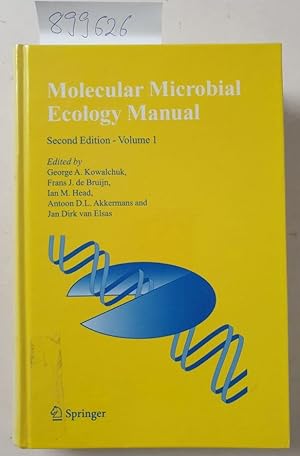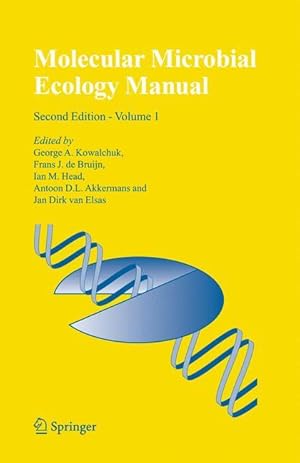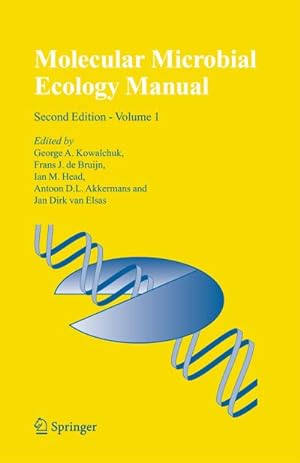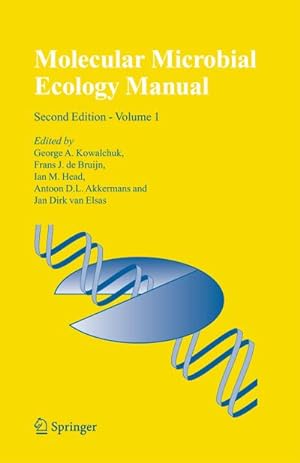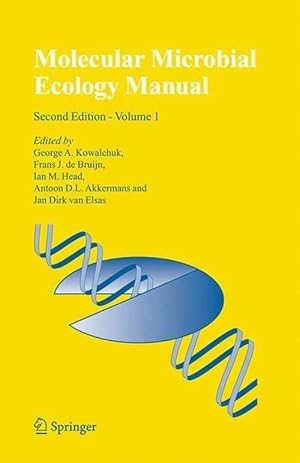Kowalchuk George (6 results)
Product Type
- All Product Types
- Books (6)
- Magazines & Periodicals
- Comics
- Sheet Music
- Art, Prints & Posters
- Photographs
- Maps
-
Manuscripts &
Paper Collectibles
Condition
Binding
- All Bindings
- Hardcover
- Softcover
Collectible Attributes
- First Edition
- Signed
- Dust Jacket
- Seller-Supplied Images (5)
- Not Printed On Demand (4)
Seller Location
Seller Rating
-
Molecular Microbial Ecology Manual : Second Edition Volume I :
Published by Berlin, Springer, 2008
ISBN 10: 1402021763ISBN 13: 9781402021763
Seller: Versand-Antiquariat Konrad von Agris e.K., Aachen, Germany
Book
8° , hardcover. Condition: Sehr gut. 1794 Seiten Ausgetragenes Bibliotheksexemplar, Buch ist in einem sehr guten Zustand, Pappeinband nachträglich mit durchsichtigem Klebeband versehen, lichtrandig, Reste eines Bibliotheketiketts, Papier in sehr gutem Zustand. ISBN: 9781402021763 . Als Versandart wählen wir immer eine schnelle Option (in Deutschland Brief oder DHL-Paket, ins Ausland Warenpost oder DHL-Paket). Preis inkl. MwSt. Sprache: Englisch Gewicht in Gramm: 3329.
-
Molecular Microbial Ecology Manual
Published by Springer Netherlands, 2007
ISBN 10: 1402021763ISBN 13: 9781402021763
Seller: Buchpark, Trebbin, Germany
Book
Condition: Sehr gut. Zustand: Sehr gut - Gepflegter, sauberer Zustand. 2. Auflage. | Seiten: 1808 | Sprache: Englisch.
-
Molecular Microbial Ecology Manual
Published by Springer Netherlands, 2004
ISBN 10: 1402021763ISBN 13: 9781402021763
Seller: moluna, Greven, Germany
Book Print on Demand
Gebunden. Condition: New. Dieser Artikel ist ein Print on Demand Artikel und wird nach Ihrer Bestellung fuer Sie gedruckt. Microbes are key drivers of the world s ecosystems. The vast majority of the world s diversity and metabolic potential lies within micro-organisms, yet with the advent of molecular-scale observation, we are still barely beginning to understand this micro.
-
Molecular Microbial Ecology Manual
Published by Springer Netherlands Aug 2004, 2004
ISBN 10: 1402021763ISBN 13: 9781402021763
Seller: BuchWeltWeit Ludwig Meier e.K., Bergisch Gladbach, Germany
Book Print on Demand
Buch. Condition: Neu. This item is printed on demand - it takes 3-4 days longer - Neuware -Microbes are key drivers of the world's ecosystems. The vast majority of the world's diversity and metabolic potential lies within micro-organisms, yet with the advent of molecular-scale observation, we are still barely beginning to understand this microscopic resource. The expanded second edition provides a detailed description of the methods that have made microbial ecology possible. 1808 pp. Englisch.
-
Molecular Microbial Ecology Manual
Published by Springer Netherlands, 2004
ISBN 10: 1402021763ISBN 13: 9781402021763
Seller: AHA-BUCH GmbH, Einbeck, Germany
Book
Buch. Condition: Neu. Druck auf Anfrage Neuware - Printed after ordering - Microbes are key drivers of the world's ecosystems. The vast majority of the world's diversity and metabolic potential lies within micro-organisms, yet we are just beginning to understand and utilize this ultimate resource of biological diversity. Critical to our exploration of the microbial world are methods that allow for the analysis of organisms that are invisible to our eyes, difficult to distinguish from each other, and often impossible to grow using available culture methods. The field of microbial ecology has been revolutionized in the past two decades by the introduction of molecular methods into the toolbox of the microbial ecologist. This molecular arsenal has helped to unveil the enormity of microbial diversity across the breadth of the earth's ecosystems, and has revealed that we are only familiar with a very small minority of the organisms that carry out key microbial functions in diverse habitats. The Molecular Microbial Ecology Manual, Second Edition (MMEM-II) provides a detailed and user-friendly description of the methods that have made this revolution in microbial ecology possible. However, what is perhaps most exciting about MMEM-II is that it contains a large number of new chapters, highlighting the newest trends in microbial ecology research, which seek to provide more quantitative and statistically robust data, and means of coupling microbial identity and function. In addition, the majority of the proven methods described in MMEM's first version have undergone significant revisions to provide the most up-to-date applications available. The state-of-the-art methods described in MMEM-II have not only been provided by experts in the field, but in most cases by the laboratories that actually first developed and applied the methods, thus providing the MMEM-II user with unique first-hand tips and insight. The new on-line format available forMMEM-II should also add to the utility of MMEM-II by allowing users to search for key topics throughout the manual, skip between interrelated chapters at the push of a button, and by providing immediate availability to protocol updates and new chapters dedicated to future technical developments.
-
Molecular Microbial Ecology Manual (Hardcover)
Published by Springer, New York, NY, 2004
ISBN 10: 1402021763ISBN 13: 9781402021763
Seller: CitiRetail, Stevenage, United Kingdom
Book
Hardcover. Condition: new. Hardcover. Microbes are key drivers of the world's ecosystems. The vast majority of the world's diversity and metabolic potential lies within micro-organisms, yet we are just beginning to understand and utilize this ultimate resource of biological diversity. Critical to our exploration of the microbial world are methods that allow for the analysis of organisms that are invisible to our eyes, difficult to distinguish from each other, and often impossible to grow using available culture methods. The field of microbial ecology has been revolutionized in the past two decades by the introduction of molecular methods into the toolbox of the microbial ecologist. This molecular arsenal has helped to unveil the enormity of microbial diversity across the breadth of the earth's ecosystems, and has revealed that we are only familiar with a very small minority of the organisms that carry out key microbial functions in diverse habitats. The Molecular Microbial Ecology Manual, Second Edition (MMEM-II) provides a detailed and user-friendly description of the methods that have made this revolution in microbial ecology possible. However, what is perhaps most exciting about MMEM-II is that it contains a large number of new chapters, highlighting the newest trends in microbial ecology research, which seek to provide more quantitative and statistically robust data, and means of coupling microbial identity and function. In addition, the majority of the proven methods described in MMEM's first version have undergone significant revisions to provide the most up-to-date applications available. The state-of-the-art methods described in MMEM-II have not only been provided by experts in the field, but in most cases by the laboratories that actually first developed and applied the methods, thus providing the MMEM-II user with unique first-hand tips and insight. The new on-line format available for MMEM-II should also add to the utility of MMEM-II by allowing users to search for key topics throughout the manual, skip between interrelated chapters at the push of a button, and by providing immediate availability to protocol updates and new chapters dedicated to future technical developments. Microbes are key drivers of the world's ecosystems. The vast majority of the world's diversity and metabolic potential lies within micro-organisms, yet we are just beginning to understand and utilize this ultimate resource of biological diversity. Critical to our exploration of the microbial world are methods that allow for the analysis of organisms that are invisible to our eyes, difficult to distinguish from each other, and often impossible to grow using available culture methods. The field of microbial ecology has been revolutionized in the past two decades by the introduction of molecular methods into the toolbox of the microbial ecologist. This molecular arsenal has helped to unveil the enormity of microbial diversity across the breadth of the earth's ecosystems, and has revealed that we are only familiar with a very small minority of the organisms that carry out key microbial functions in diverse habitats. The Molecular Microbial Ecology Manual, Second Edition (MMEM-II) provides a detailed and user-friendly description of the methods that have made this revolution in microbial ecology possible. However, what is perhaps most exciting about MMEM-II is that it contains a large number of new chapters, highlighting the newest trends in microbial ecology research, which seek to provide more quantitative and statistically robust data, and means of coupling microbial identity and function. In addition, the majority of the proven methods described in MMEM's first version have undergone significant revisions to provide the most up-to-date applications available. The state-of-the-art methods described in MMEM-II Shipping may be from our UK warehouse or from our Australian or US warehouses, depending on stock availability.


